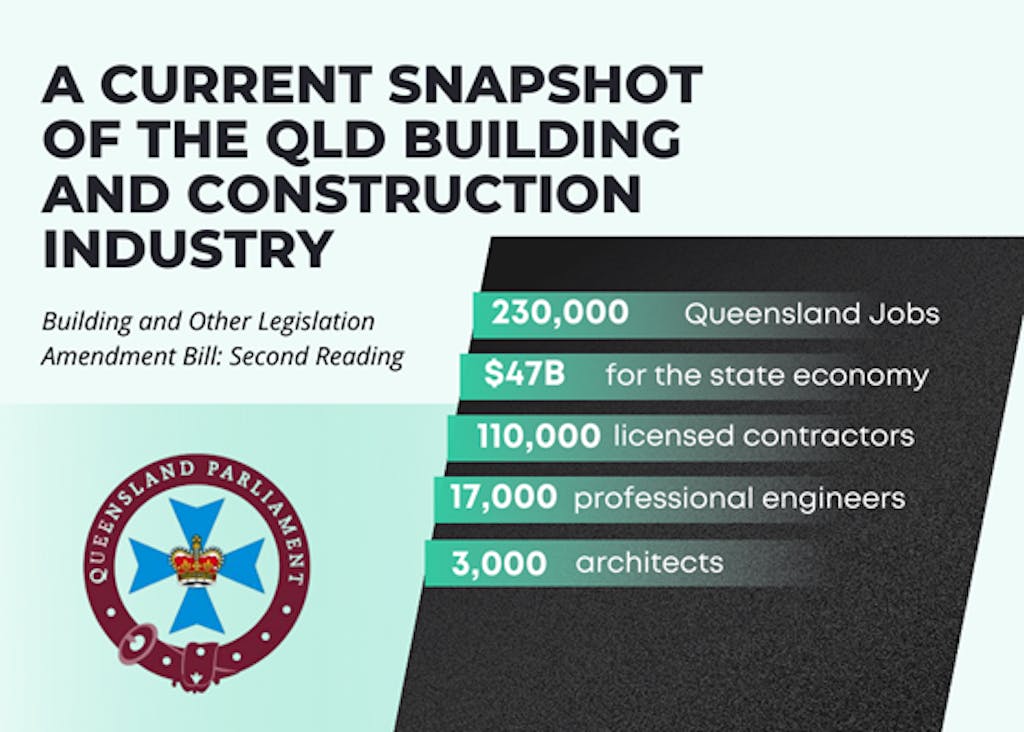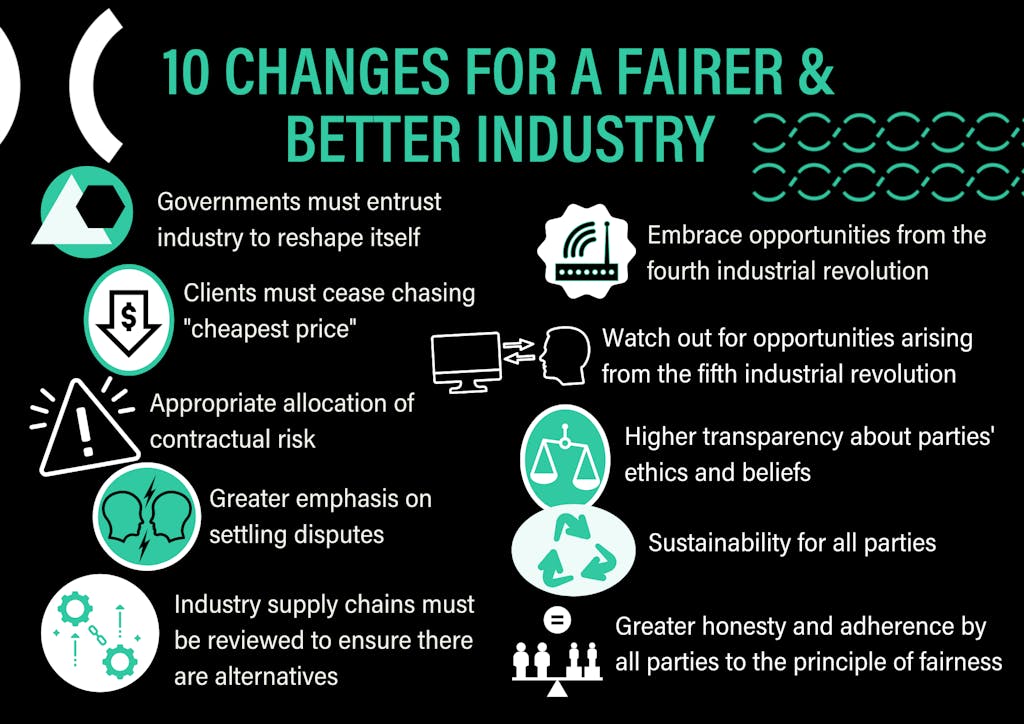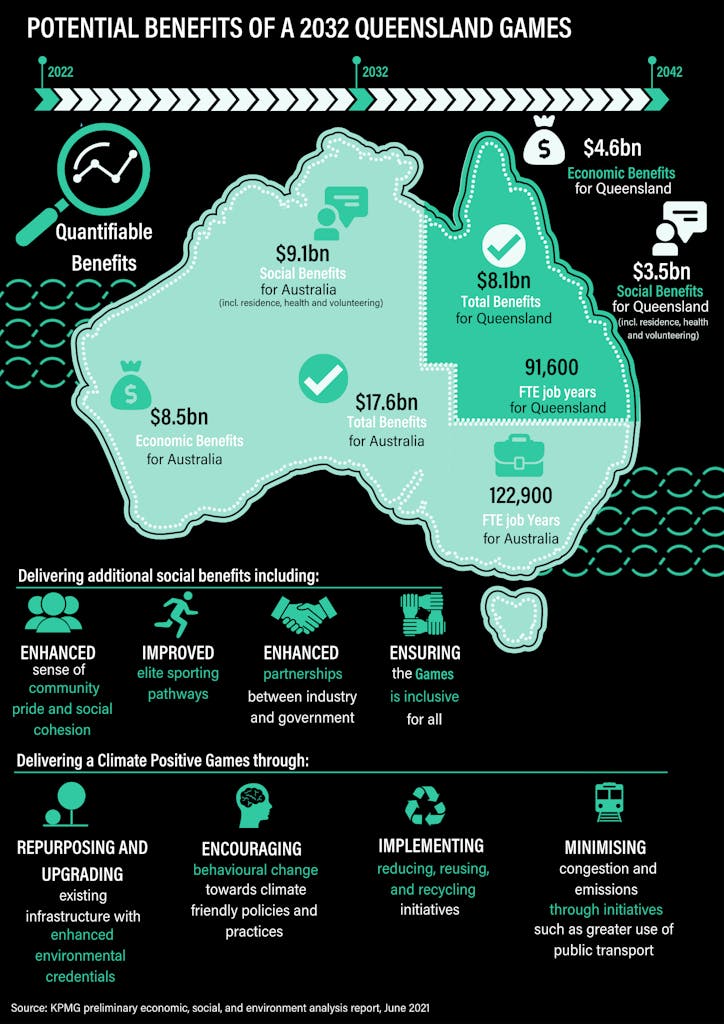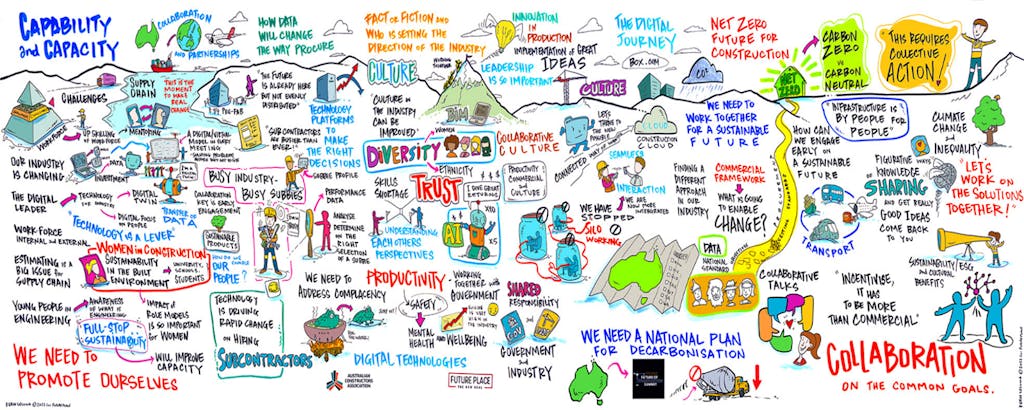The construction industry in Queensland comprises tens of thousands of people that generate $47B for our economy. I always look at all industry issues primarily from the perspective of these fellow Queenslanders.

Source: https://documents.parliament.qld.gov.au/events/han/2022/2022_05_24_WEEKLY.pdf
The industry was barely sustainable before this perfect storm.
In a report published by the Australian Contractors Association (ACA) in October 2020, entitled Constructing the Future A framework for a more sustainable construction industry, it is stated:
“The rebuilding and prosperity of our nation are therefore heavily reliant on the strength and stability of the construction industry. Reliance on an industry where profits are declining, productivity has barely improved in 20 years, cost/time over-runs are commonplace, and many projects end in contractual dispute [ACA Response to Infrastructure Australia Audit] has the potential to be problematic.”
In an article I wrote in July 2021 entitled What’s sustainability got to do with SOP?, I stated:
“Consider two very well-respected, large players in the property development and construction industries: Stockland and Hutchinson Builders.
In 2019 and 2020, both of these well respected and professional businesses achieved the same revenue of between $2.9 billion and $3.0 billion for both years. Stockland reported a net income of $640 million and $660 million respectively. Hutchinson, by contrast, reported net income of $11 million for both years.
To put this disparity into context, it is equivalent to two subcontractors with revenue of $10 million each with one returning net income of $2.2 million and the other of just $40,000.
Whilst this comparison may easily be called out as unfair based only on a sample of 2 businesses, it serves to highlight the pressures on contractors – both large and small – by the inequitable commercial frameworks prevalent in the Australian construction sector.”
The graph below reveals my views that before this new perfect storm arose, many things needed to be done to reduce insolvencies by having a fairer and more sustainable industry for all.

I first published these views in an article entitled The construction industry must build back better in 2021 in January 2021.
Perfect storm issues.
As a means to generate some thoughtful discussions, I am going to link numerous publications, reports and articles for people to consider.
A number of these articles are mine so, without any fear, I can vouch for the information outlined in them! Same for Helix infographics.
The other articles, reports and graphs I have linked all appear to me to have well-reasoned points of view. However, I am not vouching for their correctness, nor am I agreeing necessarily with their points of view.
If there is anything that jumps out to a reader as incorrect, or they merely want to put an alternative view, then please speak up!
Think of this article as a scripted podcast with several participants, where people listen respectfully to others, but then advance their views, also in a courteous manner.
Ok, let’s begin by throwing up some issues for discussion.
Insolvencies.
I have written many articles over the past several years on the terrible human blight insolvency has in the industry.
- Is there a safe harbour for a sinking ship?
- Insolvency in the building and construction industry. New thinking. Old problem
- Everybody in the construction industry deserves to be paid
- A fairer and better construction industry is feasible if we change our thinking
- New measures to address insolvency in the construction industry are urgently required
- There is a safe harbour for contractors to shelter if marooned in rough waters
- Views from the cheap seats on the construction industry are plentiful. Some are irresponsible.
My detailed research in this regard reveals that other than for the 2020/2021 Financial Year, insolvencies in the Queensland construction industry have remained roughly the same over seven years.
I explained the decline in insolvencies in 2020/2021 in an article entitled Good news = bad news in the construction industry where I indicated that every Australian jurisdiction had record low construction industry insolvencies for the 2020/2021 Financial Year as a result of:
- the ATO moratorium on issuing statutory demands and almost entirely ceasing the pursuit of outstanding taxation liabilities through the courts during this period; and
- the government COVID-19 stimulus measures.
However, industry insolvencies are now on the increase, even though the ATO continues not to take court action for outstanding liabilities. However, the big four banks are ramping up their court recoveries.
This data is expertly presented by Patrick Schweizer in his May 2022 credit risk insights by Alares.
Other perfect storm issues.
The industry is facing other perfect storm issues. These have been canvassed to death by others and I only intend to very quickly summarise them.
- The industry has and will continue to deal with numerous delays and costs increased as a result of shortages of building materials and labour.
- The importance of re-onshoring of manufacturing will be paramount if companies are to avoid escalating costs of sea freight, congestion in major ports and short supply of offshore materials.
- Securing skilled workers.
- sustained extremes in weather.
I have for the benefit of readers assembled many articles and reports that resonated with me.
- ‘On a tightrope’: Construction industry creaking under pressure
- Builders urge debt moratorium to ease crisis
- ABS construction work statistics for March 2022.
- ‘Perfect time’ to review Australian infrastructure
- Construction Sector Urged to Embrace Tech as Crisis Deepens
- The construction sector owes a staggering $7.22 billion to the ATO
- Australia’s Top 10 Builders Weigh In On Construction Industry
- 96 building licences cancelled over questions about finances
- CSQ Industry Outlook for Queensland’s construction industry
Final thoughts
If readers desire to be informed on all issues relating specifically to the Queensland industry, do yourself a favour and read all the current publications produced by Construction Skills Queensland (CSQ).
The CSQ is an outstanding resource centre we should all be very proud of.
What should parties do to help each other?
Despite the heading of this article, I am not advocating that parties deal on a ‘mates basis’, chuck the contract away and ignore all prudent contract administration processes and procedures. That would produce shocking outcomes.
What I am encouraging all parties to do is take an opportunity to reflect on the impact they will have on their people and the people of other contracted parties as they are about to make crucial decisions.
Is there any opportunity to help a contracted party if you are a contracting party? If you are a contracted party, is there anything else you can do over and above the contract terms to assist the contracting party?
With respect to making changes to the contract – that is way above my pay scale !!!
I have noted a thoughtful blog along these lines by Kate Raymond, National Policy Lead at the ACA, and I would encourage readers to have read to see if anything does resonate with you. The blog is entitled Locked in-who wins?. The elephant in the room that we are now just speaking about is what will the banks do?
In an article entitled [+] Rising Construction Costs: Will Banks ‘Play Ball’?, it is stated:
“Rise and fall clauses in building contracts are increasingly on the table as developers and builders team up to crunch the numbers to hold Australia’s teetering construction industry together.
But a significant risk remains from the sector’s most critical allies in the battle to prevail through the “profitless boom”.
“There is a risk that some of the important parties that make building work happen—and I’m talking principally about banks and other financiers—may not play ball,” Master Builders Australia chief economist Shane Garrett said.”
The article is well worth a read.
Forever the optimist, happy days are coming and we need to not lose focus of this fact.
Below is just one such example.

Solutions exist for a more sustainable industry
Finally, I leave you with artwork from the Future of Construction Summit 2022, where all the solutions exist for a more sustainable industry and therefore reduced insolvencies. There are solutions, don’t despair!!


Not intended as legal advice. Read full disclaimer.



